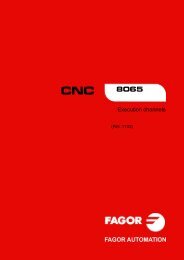4 - Fagor Automation
4 - Fagor Automation
4 - Fagor Automation
Create successful ePaper yourself
Turn your PDF publications into a flip-book with our unique Google optimized e-Paper software.
3.<br />
CYCLE EDITOR<br />
CNC 8065<br />
·88·<br />
Simulate a canned cycle.<br />
(REF: 1209)<br />
3.4 Simulate a canned cycle.<br />
i<br />
Canned cycles (·M· model)<br />
With the canned cycle editor, it is possible to simulate the cycle being edited without having<br />
to simulate the whole part-program. During simulation, the editor allows viewing and editing<br />
another canned cycle and also returning to the program editor.<br />
If the cycle editor is included in the automatic operating mode, it will not be possible to simulate a cycle.<br />
Simulating a cycle<br />
Pressing the [START] icon begins the simulation of the cycle that is being edited. The<br />
simulation may be interrupted with the [STOP] icon or canceled with the [RESET] icon.<br />
START STOP RESET<br />
The simulation graphics is always superimposed on the help graphics of the main cycle. If<br />
the cycle has a positioning associated with it, the graphics is superimposed on the main<br />
cycle; in the case of a 2D pocket with drilling, on the pocket.<br />
Once the simulation has started, it is maintained until the cycle is over or the [RESET] icon<br />
is pressed. Even when changing cycles or returning to the program editor during simulation,<br />
the previous cycle is still in effect during the simulation.<br />
Cycle simulation window<br />
The graphics window (in simulation) is activated by pressing the [START] icon and is<br />
canceled by pressing the [RESET] icon. This window is placed over the cycle help graphics;<br />
it may be expanded to full screen (or shrunk again) using the key combination [CTRL]+[G].<br />
The lower left corner of the window indicates the name of the cycle and the simulation<br />
channel, which will be the channel of the program editor from which the cycle editor has been<br />
called.<br />
Configuring the graphic environment<br />
When activating or selecting the graphics window, the horizontal softkey menu shows the<br />
available graphic options. For further information on the graphic options, see the chapter on<br />
the edit-simulation mode of the operation manual.<br />
Some graphic options can also be edited manually. The editing area is only shown when the<br />
window is expanded ([CTRL]+[G]).<br />
The simulated graphics are maintained until erased; i.e. starting to simulate a new cycle does<br />
not erase the previous graphics.<br />
Best area for displaying the graphics<br />
The display area may be established from the softkey menu associated with the simulation<br />
graphics window or may be left up to the CNC to periodically calculate the best area.<br />
While the graphics window is visible, the key combination [CTRL]+[D] activates the<br />
calculation of the best area. From that moment on and until quitting the cycle editor, the CNC<br />
periodically calculates the best display are for the graphics. When quitting the graphics, it<br />
will assume as the new display area the one calculated last.<br />
Window for simulation and data editing<br />
While the graphics window is selected, it may be switched to the cycle parameter area using<br />
the direct access keys. If the parameter belongs to a positioning cycle, firs press [CTRL]+[F2]<br />
(window change)

















